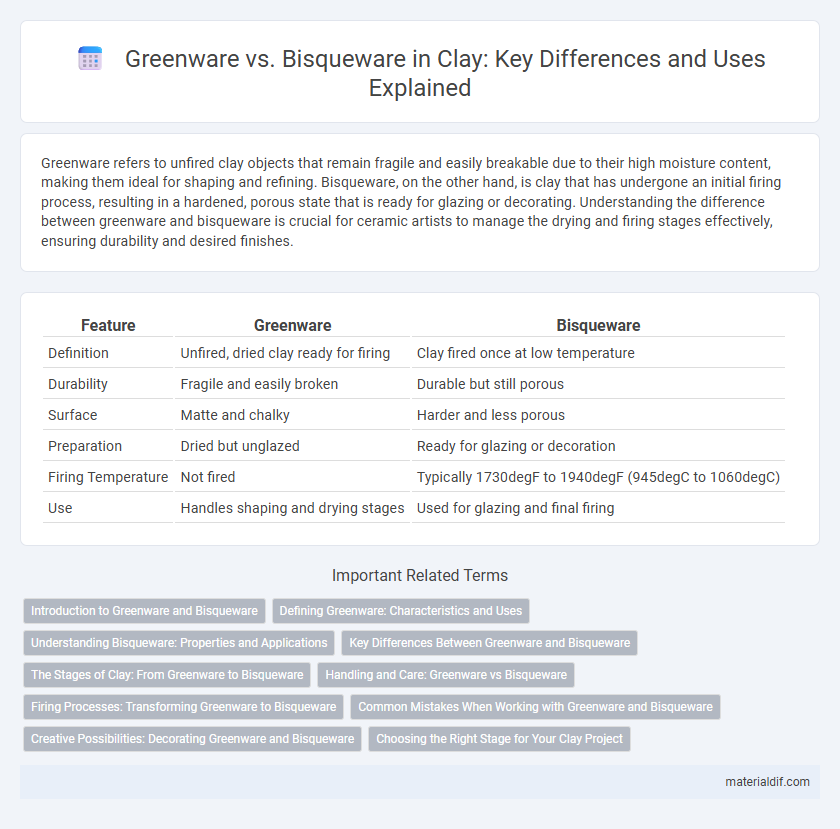Greenware refers to unfired clay objects that remain fragile and easily breakable due to their high moisture content, making them ideal for shaping and refining. Bisqueware, on the other hand, is clay that has undergone an initial firing process, resulting in a hardened, porous state that is ready for glazing or decorating. Understanding the difference between greenware and bisqueware is crucial for ceramic artists to manage the drying and firing stages effectively, ensuring durability and desired finishes.
Table of Comparison
| Feature | Greenware | Bisqueware |
|---|---|---|
| Definition | Unfired, dried clay ready for firing | Clay fired once at low temperature |
| Durability | Fragile and easily broken | Durable but still porous |
| Surface | Matte and chalky | Harder and less porous |
| Preparation | Dried but unglazed | Ready for glazing or decoration |
| Firing Temperature | Not fired | Typically 1730degF to 1940degF (945degC to 1060degC) |
| Use | Handles shaping and drying stages | Used for glazing and final firing |
Introduction to Greenware and Bisqueware
Greenware refers to unfired clay objects that are shaped and dried but remain fragile and porous, making them easy to reshape or repair before firing. Bisqueware is clay that has undergone the initial firing process in a kiln, resulting in hardened, durable pieces that are ready for glazing or further decoration. Understanding the transition from greenware to bisqueware is essential for ceramic artists to achieve desired textures and structural integrity in their work.
Defining Greenware: Characteristics and Uses
Greenware refers to unfired clay pieces that are fragile, porous, and highly sensitive to moisture. It is the initial stage in the pottery process, featuring soft, malleable textures ideal for shaping and detailed work before kiln firing. Artists use greenware primarily for sculpting and drying, as it must be completely dried before transitioning to bisqueware to avoid cracking during firing.
Understanding Bisqueware: Properties and Applications
Bisqueware refers to pottery that has been fired once at a lower temperature, resulting in a porous and durable ceramic that is ideal for glazing and painting. Its porous nature allows it to absorb glazes effectively, making it a versatile base for decorative and functional pottery. Commonly used in both artistic and practical ceramic works, bisqueware provides a sturdy foundation before the final glaze firing, enhancing both durability and aesthetic appeal.
Key Differences Between Greenware and Bisqueware
Greenware refers to unfired clay pieces that are still fragile and contain moisture, making them prone to breakage or deformation. Bisqueware is clay that has undergone the first firing in a kiln, resulting in a hardened, porous state that is more durable but still absorbent. Key differences include greenware's vulnerability to handling and bisqueware's readiness for glazing and final firing processes.
The Stages of Clay: From Greenware to Bisqueware
Greenware refers to unfired clay objects that are fragile and contain all their moisture, making them prone to breakage during handling. Bisqueware is the stage after greenware has been fired once in a kiln at a temperature ranging from 1730degF to 1940degF (945degC to 1060degC), resulting in a hardened, porous material ready for glazing. This transformation from greenware to bisqueware is crucial, as it stabilizes the clay by removing chemical water and prepares the piece for further decorative processes.
Handling and Care: Greenware vs Bisqueware
Greenware is extremely fragile and highly susceptible to damage from moisture and physical impact, requiring careful, gentle handling to avoid cracks or breakage before firing. Bisqueware, having undergone an initial firing, is more durable and less vulnerable to water, allowing for easier handling during glazing and decoration. Proper support and minimal contact remain crucial for greenware, while bisqueware can tolerate moderate handling but still benefits from cautious care to prevent chipping.
Firing Processes: Transforming Greenware to Bisqueware
Greenware, consisting of unfired clay, undergoes a critical firing process in a kiln that transforms it into bisqueware, a hardened, porous state. This initial bisque firing typically occurs at temperatures between 1730degF and 1940degF (945degC to 1060degC), which burns out all moisture while maintaining the clay's structural integrity. The transformation results in a durable yet porous bisqueware, ideal for glazing and further firing stages.
Common Mistakes When Working with Greenware and Bisqueware
Common mistakes when working with greenware include handling it while it's still too wet, leading to deformation or cracking, and neglecting to score and slip before joining pieces, which causes weak joints. In contrast, bisqueware errors often involve overfiring, which makes the clay too brittle and porous, or glazing unevenly, resulting in poor adhesion and surface defects. Proper timing in drying and firing stages is critical to avoid structural failures in both greenware and bisqueware.
Creative Possibilities: Decorating Greenware and Bisqueware
Greenware offers unique creative possibilities through its soft, unfired state, allowing artists to carve, incise, and add intricate textures with ease before the initial kiln firing. Bisqueware, having undergone the first firing, provides a hardened surface ideal for detailed glaze application, underglaze painting, and layering techniques that enhance color vibrancy and durability. Understanding the distinct decorating opportunities of greenware and bisqueware expands artistic expression within ceramic art.
Choosing the Right Stage for Your Clay Project
Choosing the right stage between greenware and bisqueware is crucial for successful clay projects. Greenware, being unfired and fragile, allows for easy carving and joining but requires careful handling to avoid breakage. Bisqueware, having undergone initial firing, offers durability for glazing and finishing, making it ideal for final surface treatments.
Greenware vs Bisqueware Infographic

 materialdif.com
materialdif.com